Paris Peace Conference (1919–1920)
| Paris Peace Conference |
|---|
 |
The Paris Peace Conference was a set of formal and informal diplomatic meetings in 1919 and 1920 after the end of World War I, in which the victorious Allies set the peace terms for the defeated Central Powers. Dominated by the leaders of Britain, France, the United States and Italy, the conference resulted in five treaties that rearranged the maps of Europe and parts of Asia, Africa and the Pacific Islands, and also imposed financial penalties. Germany, Austria-Hungary, Turkey and the other losing nations were not given a voice in the deliberations; this later gave rise to political resentments that lasted for decades. The arrangements made by this conference are considered one of the great watersheds of 20th-century geopolitical history.[1]
The conference involved diplomats from
US President
The main result of the conference was the
The conference began on 18 January 1919. With respect to its end, Professor
Overview and direct results
This section needs additional citations for verification. (January 2019) |
The Conference formally opened on 18 January 1919 at the Quai d'Orsay in Paris.
The five major powers, France, Britain, Italy, the U.S., and Japan, controlled the Conference. Amongst the "Big Five", in practice Japan only sent a former prime minister and played a small role; and the "
Five major peace treaties were prepared at the Paris Peace Conference, with, in parentheses, the affected countries:
- the Treaty of Versailles, 28 June 1919 (Germany)
- the Austria)
- the Treaty of Neuilly, 27 November 1919 (Bulgaria)
- the Hungary)
- the Republic of Turkey).
The major decisions were the establishment of the League of Nations; the five peace treaties with defeated enemies; the awarding of German and Ottoman overseas possessions as "mandates", chiefly to members of the British Empire and to France; reparations imposed on Germany; and the drawing of new national boundaries, sometimes with plebiscites, to better reflect the forces of nationalism. The main result was the Treaty of Versailles, with Germany, which in section 231 laid the guilt for the war on "the aggression of Germany and her allies".[11] This provision proved humiliating for Germany and set the stage for very high reparations Germany was supposed to pay. Germany paid only a small portion, before reparations ended in 1931. According to British historian AJP Taylor, the treaty seemed to Germans "wicked, unfair" and "dictation, a slave treaty" but one which they would repudiate at some stage if it "did not fall to pieces of its own absurdity."[12]
As the conference's decisions were enacted
The League of Nations proved controversial in the United States since critics said it subverted the powers of the
Mandates
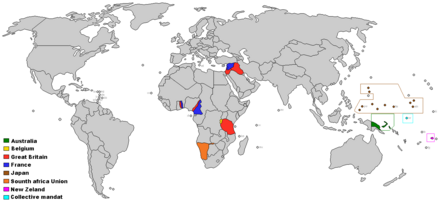
A central issue of the conference was the disposition of the overseas colonies of Germany (Austria-Hungary did not have major colonies, and the Ottoman Empire was a separate issue).[13][14]
The British dominions wanted their reward for their sacrifice. Australia wanted New Guinea, New Zealand wanted Samoa, and South Africa wanted South West Africa. Wilson wanted the League to administer all German colonies until they were ready for independence. Lloyd George realized he needed to support his dominions and so he proposed a compromise: there be three types of mandates. Mandates for the Turkish provinces were one category and would be divided up between Britain and France.
The second category, of New Guinea, Samoa, and South West Africa, were located so close to responsible supervisors that the mandates could hardly be given to anyone except Australia, New Zealand, and South Africa. Finally, the African colonies would need the careful supervision as "Class B" mandates, which could be provided only by experienced colonial powers: Britain, France, and Belgium although Italy and Portugal received small amounts of territory. Wilson and the others finally went along with the solution.
Wilson wanted no mandates for the United States, but his main advisor,
- Wilson:
But after all, you speak for only five million people.
Hughes:I represent sixty thousand dead.
[20]
British approach

The maintenance of the unity, territories, and interests of the British Empire was an overarching concern for the British delegates to the conference. Still, they entered the conference with more specific goals with this order of priority:
- Ensure colonial claims of Germany were redacted (taken or given to victory colonies)
- Germany was ensued with 30 billion dollars of debt, concerning interest
- Ensuring the security of France
- Removing the threat of the German High Seas Fleet
- Settling territorial contentions
- Supporting the League of Nations[21]
The Racial Equality Proposal put forth by the Japanese did not directly conflict with any core British interest, but as the conference progressed, its full implications on immigration to the
Ultimately, the British delegation did not treat that proposal as a fundamental aim of the conference; they were willing to sacrifice the Racial Equality Proposal to placate the Australian delegation and thus help to satisfy their overarching aim of preserving the unity of the British Empire.[22]
Britain had reluctantly consented to the attendance of separate delegations from British dominions, but the British managed to rebuff attempts by the envoys of the newly proclaimed
David Lloyd George commented that he did "not do badly" at the peace conference "considering I was seated between
Dominion representation

The dominion governments were not originally given separate invitations to the conference and had been expected to send representatives as part of the British delegation.[25]
Convinced that Canada had become a nation on the battlefields of Europe, Prime Minister
Canada, despite its huge losses in the war, did not ask for either reparations or mandates.[27]
The Australian delegation, led by Australian Prime Minister Billy Hughes fought greatly for its demands: reparations, the annexation of German New Guinea, and the rejection of the Racial Equality Proposal. He said that he had no objection to the proposal if it was stated in unambiguous terms that it did not confer any right to enter Australia. He was concerned by the increasing power of Japan. Within months of the declaration of war in 1914, Japan, Australia, and New Zealand had seized all of Germany's possessions in the Far East and the Pacific Ocean. The British had given their blessing for Japan to occupy German possessions, but Hughes was alarmed by that policy.[28]
French approach

French Prime Minister Georges Clemenceau controlled his delegation, and his chief goal was to weaken Germany militarily, strategically, and economically.[29][30] Having personally witnessed two German attacks on French soil in the last 40 years, he was adamant for Germany not to be permitted to attack France again. Particularly, Clemenceau sought an American and British joint guarantee of French security in the event of another German attack.
Clemenceau also expressed skepticism and frustration with Wilson's Fourteen Points and complained: "Mr. Wilson bores me with his fourteen points. Why, God Almighty has only ten!" Wilson gained some favour by signing a mutual defense treaty with France, but he did not present it to his country's government for ratification and so it never took effect.[31]
Another possible French policy was to seek a rapprochement with Germany. In May 1919 the diplomat René Massigli was sent on several secret missions to Berlin. During his visits, he offered, on behalf of his government, to revise the territorial and economic clauses of the upcoming peace treaty.[32] Massigli spoke of the desirability of "practical, verbal discussions" between French and German officials that would lead to a "Franco-German collaboration."[32]
Massigli told the Germans that the French thought of the "Anglo-Saxon powers" (the United States and the British Empire) as the major threat to France in the post-war world. He argued that both France and Germany had a joint interest in opposing "Anglo-Saxon domination" of the world, and he warned that the "deepening of opposition" between the French and the Germans "would lead to the ruin of both countries, to the advantage of the Anglo-Saxon powers."[33]
The Germans rejected Massigli's offers because they believed that the intention was to trick them into accepting the Treaty of Versailles unchanged; also, the German Foreign Minister, Count Ulrich von Brockdorff-Rantzau, thought that the United States was more likely to reduce the severity of the penalties than France was.[33] (Lloyd George was the one who eventually pushed for better terms for Germany.)
Italian approach
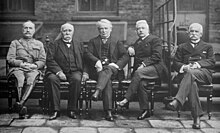
In 1914, Italy remained neutral despite the
(in Turkey), and possibly colonies in Africa.Italian Prime Minister
Orlando, unable to speak English, conducted negotiations jointly with his Foreign Minister
Orlando obtained other results, such as the permanent membership of Italy in the
There was a general disappointment in Italy, which the nationalists and fascists used to build the idea that Italy was betrayed by the Allies and refused what had been promised. That was a cause for the general rise of Italian fascism. Orlando refused to see the war as a mutilated victory and replied to nationalists calling for a greater expansion, "Italy today is a great state... on par with the great historic and contemporary states. This is, for me, our main and principal expansion."
Japanese approach


Japan sent a large delegation, headed by the former Prime Minister, Marquis Saionji Kinmochi. It was originally one of the "big five" but relinquished that role because of its slight interest in European affairs. Instead, it focused on two demands: the inclusion of its Racial Equality Proposal in the League's Covenant and Japanese territorial claims with respect to former German colonies: Shantung (including Kiaochow) and the Pacific islands north of the Equator, the Marshall Islands, Micronesia, the Mariana Islands, and the Carolines.[37]
The former Foreign Minister Baron Makino Nobuaki was de facto chief. Saionji's role was symbolic and limited because of his history of ill-health. The Japanese delegation became unhappy after it had received only half of the rights of Germany, and it then walked out of the conference.[38]
Racial equality proposal
During the negotiations, the leader of the Japanese delegation, Saionji Kinmochi, proposed the inclusion of a "racial equality clause" in the Covenant of the League of Nations on 13 February as an amendment to Article 21:[39]
The equality of nations being a basic principle of the League of Nations, the High Contracting Parties agree to accord as soon as possible to all alien nationals of states, members of the League, equal and just treatment in every respect making no distinction, either in law or in fact, on account of their race or nationality.
The clause quickly proved problematic to both the American and British delegations. Though the proposal itself was compatible with Britain's stance of nominal equality for all British subjects as a principle for maintaining imperial unity, there were significant deviations in the stated interests of its dominions, notably Australia and South Africa. Though both dominions could not vote on the decision individually, they were strongly opposed to the clause and pressured Britain to do likewise. Ultimately, the British delegation succumbed to imperial pressure and abstained from voting for the clause.[40][41]
Meanwhile, though Wilson was indifferent to the clause, there was fierce resistance to it from the American public, and he ruled as Conference chairman that a unanimous vote was required for the Japanese proposal to pass. Ultimately, on the day of the vote, only 11 of the 17 delegates voted in favor of the proposal.[42][43] The defeat of the proposal influenced Japan's turn from co-operation with the Western world, into more nationalist and militarist policies and approaches.[44]
Territorial claims
The Japanese
Despite a generally pro-Chinese view by the American delegation, Article 156 of the Treaty of Versailles transferred German concessions in the Jiaozhou Bay, China, to Japan rather than returning sovereign authority to China. The leader of the Chinese delegation, Lu Zhengxiang, demanded a reservation be inserted, before he would sign the treaty. After the reservation was denied, the treaty was signed by all the delegations except that of China. Chinese outrage over that provision led to demonstrations known as the May Fourth Movement. The Pacific Islands north of the equator became a class C mandate, administered by Japan.[46]
American approach
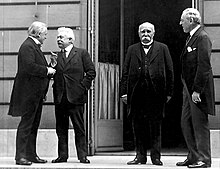
Until Wilson's arrival in Europe in December 1918, no sitting American president had ever visited the continent.[47] Wilson's 1918 Fourteen Points had helped win many hearts and minds as the war ended, not only in America but all over Europe, including Germany, as well as its allies in and the former subjects of the Ottoman Empire.
Wilson's diplomacy and his Fourteen Points had essentially established the conditions for the armistices that had brought an end to World War I. Wilson felt it to be his duty and obligation to the people of the world to be a prominent figure at the peace negotiations. High hopes and expectations were placed on him to deliver what he had promised for the postwar era. In doing so, Wilson ultimately began to lead the foreign policy of the United States towards interventionism, a move that has been strongly resisted in some United States circles ever since.
Once Wilson arrived, however, he found "rivalries, and conflicting claims previously submerged."[48] He worked mostly at trying to influence both the French, led by Georges Clemenceau, and the British, led by David Lloyd George, in their treatment of Germany and its allies in Europe and the former Ottoman Empire in the Middle East. Wilson's attempts to gain acceptance of his Fourteen Points ultimately failed; France and Britain each refused to adopt specific points as well as certain core principles.
Several of the Fourteen Points conflicted with the desires of European powers. The United States did not consider it fair or warranted that
respectively.)In the Middle East, negotiations were complicated by competing aims and claims, and the new mandate system. The United States expressed a hope to establish a more liberal and diplomatic world as stated in the Fourteen Points, in which democracy, sovereignty, liberty and self-determination would be respected. France and Britain, on the other hand, already controlled empires through which they wielded power over their subjects around the world, and aspired to maintain and expand their colonial power rather than relinquish it.
In light of the previously-secret Sykes–Picot Agreement and following the adoption of the mandate system on the Arab provinces of the former Ottoman Empire, the conference heard statements from competing Zionists and Arabs. Wilson then recommended an international commission of inquiry to ascertain the wishes of the local inhabitants. The idea, first accepted by Great Britain and France, was later rejected, but became the purely-American King–Crane Commission which toured all Syria and Palestine during the summer of 1919 taking statements and sampling opinion.[48] Its report, presented to Wilson, was kept secret from the public until The New York Times broke the story in December 1922.[53] A pro-Zionist joint resolution on Palestine was passed by the United States Congress in September 1922.[54]
France and Britain tried to appease Wilson by consenting to the establishment of his
Greek approach
Greek Prime Minister Eleftherios Venizelos took part in the conference as Greece's chief representative. Wilson was said to have placed Venizelos first for personal ability among all delegates in Paris.[56]
Venizelos proposed Greek expansion in
As a liberal politician, Venizelos was a strong supporter of the Fourteen Points and the League of Nations.
Chinese approach
The Chinese delegation was led by
Other nations' approach
All-Russian Government (Whites)
While Russia was formally excluded from the Conference[58] although it had fought against the Central Powers for three years. However the Russian Provincial Council (chaired by Prince Lvov[59]), the successor to the Russian Constituent Assembly and the political arm of the Russian White movement attended the conference and was represented by the former tsarist minister Sergey Sazonov,[4] who, if the tsar had not been overthrown, would most likely have attended the conference anyway. The Council maintained the position of an indivisible Russia, but some were prepared to negotiate over the loss of Poland and Finland.[60] The Council suggested all matters relating to territorial claims or demands for autonomy within the former Russian Empire be referred to a new All-Russian Constituent Assembly.
Baltic states
Delegations from the Baltic states of
Ukraine

Belarus
A delegation of the
Minority rights
At the insistence of Wilson, the Big Four required Poland to sign a treaty on 28 June 1919 that guaranteed minority rights in the new nation. Poland signed under protest and made little effort to enforce the specified rights for Germans, Jews, Ukrainians, and other minorities. Similar treaties were signed by Czechoslovakia, Romania, Yugoslavia, Greece, Austria, Hungary, and Bulgaria and later by Latvia, Estonia, and Lithuania. Estonia had already given cultural autonomy to minorities in its declaration of independence. Finland and Germany were not asked to sign a minority treaty.[65]
In Poland, the key provisions were to become fundamental laws, which would override any national legal codes or legislation. The new country pledged to assure "full and complete protection of life and liberty to all individuals... without distinction of birth, nationality, language, race, or religion." Freedom of religion was guaranteed to everyone. Most residents were given citizenship, but there was considerable ambiguity on who was covered. The treaty guaranteed basic civil, political, and cultural rights and required all citizens to be equal before the law and enjoy identical rights of citizens and workers.
Caucasus
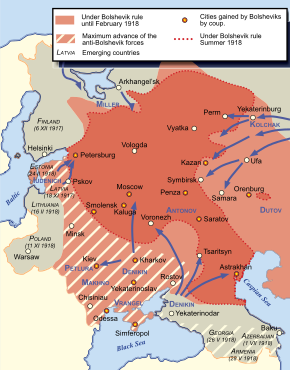
The three South Caucasian republics of Armenia, Azerbaijan, and Georgia and the Mountainous Republic of the Northern Caucasus all sent a delegation to the conference. Their attempts to gain protection from threats posed by the ongoing Russian Civil War largely failed since none of the major powers was interested in taking a mandate over the Caucasian territories. After a series of delays, the three South Caucasian countries ultimately gained de facto recognition from the Supreme Council of the Allied powers but only after all European troops had been withdrawn from the Caucasus, except for a British contingent in Batumi. Georgia was recognized de facto on 12 January 1920, followed by Azerbaijan the same day and Armenia on 19 January 1920. The Allied leaders decided to limit their assistance to the Caucasian republics to the supply of arms, munitions, and food.[68]
The Armenian delegation included
Korea
After a failed attempt by the
Palestine
After the conference's decision to separate the former Arab provinces from the Ottoman Empire and to apply the new mandate-system to them, the World Zionist Organization submitted its draft resolutions for consideration by the conference.
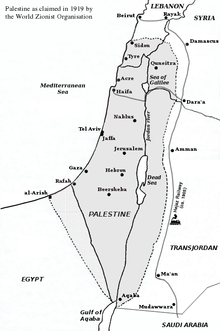

The February 1919 statement included the following main points: recognition of Jewish "title" over the land, a declaration of the borders (significantly larger than in the prior
Assyrians
Up to 300 000
Aromanians
During the Peace Conference, a delegation of Aromanians participated in order to fulfill autonomist wishes for the Aromanian people in the same vein as the Samarina Republic attempt two years earlier, but failed to accomplish any recognition for the self-rule desires of their people.[75]
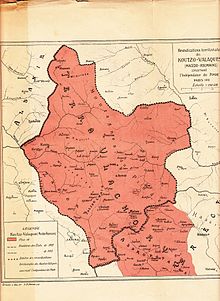
Women's approach
An unprecedented aspect of the conference was concerted pressure brought to bear on delegates by a committee of women, who sought to establish and entrench women's fundamental social, economic, and political rights, such as that of suffrage, within the peace framework. Although they were denied seats at the Paris Conference, the leadership of Marguerite de Witt-Schlumberger, the president of the French Union for Women's Suffrage, caused an Inter-Allied Women's Conference (IAWC) to be convened, which met from 10 February to 10 April 1919.[76][77]
The IAWC lobbied Wilson and then the other delegates of the Paris Conference to admit women to its committees, and it was successful in achieving a hearing from the conference's Commissions for International Labour Legislation and then the League of Nations Commission. One key and concrete outcome of the IAWC's work was Article 7 of the Covenant of the League of Nations: "All positions under or in connection with the League, including the Secretariat, shall be open equally to men and women." More generally, the IAWC placed the issue of women's rights at the center of the new world order that was established in Paris.[76][77]
Historical assessments
The remaking of the world map at the conferences gave birth to a number of critical conflict-prone contradictions internationally that would become some of the causes of World War II.[78] The British historian Eric Hobsbawm claimed:
[N]o equally systematic attempt has been made before or since, in Europe or anywhere else, to redraw the political map on national lines.... The logical implication of trying to create a continent neatly divided into coherent territorial states each inhabited by separate ethnically and linguistically homogeneous population, was the mass expulsion or extermination of minorities. Such was and is the reductio ad absurdum of nationalism in its territorial version, although this was not fully demonstrated until the 1940s.[79]
Hobsbawm and other left-wing historians have argued that Wilson's Fourteen Points, particularly the principle of self-determination, were measures that were primarily against the Bolsheviks and designed, by playing the nationalist card, to tame the revolutionary fever that was sweeping across Europe in the wake of the
The right-wing historian John Lewis Gaddis agreed: "When Woodrow Wilson made the principle of self-determination one of his Fourteen Points his intent had been to undercut the appeal of Bolshevism."[81]
That view has a long history and can be summarised by Ray Stannard Baker's famous remark: "Paris cannot be understood without Moscow."[82]
The British historian Antony Lentin viewed Lloyd George's role in Paris as a major success:
Unrivaled as a negotiator, he had powerful combative instincts and indomitable determinism, and succeeded through charm, insight, resourcefulness, and simple pugnacity. Although sympathetic to France's desires to keep Germany under control, he did much to prevent the French from gaining power, attempted to extract Britain from the Anglo-French entente, inserted the war-guilt clause, and maintained a liberal and realist view of the postwar world. By doing so, he managed to consolidate power over the House [of Commons], secured his power base, expanded the empire, and sought a European balance of power.[83][failed verification]
Cultural references
- British official artists William Orpen and Augustus John were present at the Conference.
- Lanny Buddseries, describes the political machinations and consequences of the Paris Peace Conference through much of the book's second half, with Sinclair's narrative including many historically accurate characters and events.
- The first two books of novelist Robert Goddard's The Wide World trilogy (The Ways of the World and The Corners of the Globe) are centered around the diplomatic machinations which form the background to the conference.
- Paris 1919 (1973), the third studio album by Welsh musician John Cale, is named after the Paris Peace Conference, and its title song explores various aspects of early-20th-century culture and history in Western Europe.
- A Dangerous Man: Lawrence After Arabia (1992) is a British television film starring Ralph Fiennes as T. E. Lawrence and Alexander Siddig as Emir Faisal, depicting their struggles to secure an independent Arab state at the conference.
- "Paris, May 1919" is a 1993 episode of The Young Indiana Jones Chronicles, written by Jonathan Hales and directed by David Hare, in which Indiana Jones is shown working as a translator with the American delegation at the Paris Peace Conference.
See also
References
- ^ Showalter, Dennis E.; Royde-Smith, John Graham (30 October 2023). "World War I | History, Summary, Causes, Combatants, Casualties, Map, & Facts | Britannica". www.britannica.com. Retrieved 31 October 2023.
- ^ a b Rene Albrecht-Carrie, Diplomatic History of Europe Since the Congress of Vienna (1958) p. 363
- ISBN 978-0-19-065918-9.
- ^ a b Erik Goldstein The First World War Peace Settlements, 1919–1925 p. 49 Routledge (2013)
- ISSN 0261-3077. Retrieved 27 April 2019.
- ISBN 978-1317883678.
- ^
ISBN 978-1459627376. Retrieved 19 February 2017.
[...] Ebert persuaded the various councils to set elections for 19 January 1919 (the day following a date symbolic in Prussian history ever since the Kingdom of Prussia was established on 18 January 1701).
- ^
Meehan, John David (2005). "4: Failure at Geneva". The Dominion and the Rising Sun: Canada Encounters Japan, 1929–41. Vancouver: UBC Press. pp. 76–77. ISBN 978-0774811217. Retrieved 19 February 2017.
As the first non-European nation to achieve great-power status, Japan took its place alongside the other Big Five at Versailles, even if it was often a silent partner.
- ^ Antony Lentin, "Germany: a New Carthage?" History Today (2012) 62#1 pp. 22–27 online
- ^ Paul Birdsall, Versailles Twenty Years After (1941) is a convenient history and analysis of the conference. Longer and more recent is Margaret Macmillan, Peacemakers: The Paris Peace Conference of 1919 and Its Attempt to End War (2002), also published as Paris 1919: Six Months That Changed the World (2003); a good short overview is Alan Sharp, The Versailles Settlement: Peacemaking after the First World War, 1919–1923 (2nd ed. 2008)
- ISBN 0-14-002481-6.
- ISBN 0-14-002481-6.
- ^ Alan Sharp, The Versailles Settlement: Peacemaking After the First World War, 1919–1923 (2nd ed. 2008) ch 7
- JSTOR 260018.
- ISBN 0214200493.
- S2CID 143884972.
- ^ Paul Birdsall, Versailles Twenty Years After (1941) pp. 58–82
- ^ Macmillan, Paris 1919, pp. 98–106
- ^ Scot David Bruce, Woodrow Wilson's Colonial Emissary: Edward M. House and the Origins of the Mandate System, 1917–1919 (University of Nebraska Press, 2013)
- ISBN 978-1863955874.
- ISBN 978-0199226863.
- ^ Shimazu (1998), pp. 14–15, 117.
- ^ "Documents on Irish Foreign Policy – Volume 1".
- ISBN 978-0230100909.
- .
- .
- ^ Margaret McMillan, "Canada and the Peace Settlements", in David Mackenzie, ed., Canada and the First World War (2005) pp. 379–408
- .
- ^ MacMillan, Paris 1919 pp. 26–35
- ^ David Robin Watson, Georges Clemenceau (1974) pp. 338–365
- JSTOR 1890194.
- ^ S2CID 145777701.
- ^ a b Trachtenberg (1979), p. 43.
- ^ Macmillan, ch 22
- ^ H. James Burgwyn, Legend of the Mutilated Victory: Italy, the Great War and the Paris Peace Conference, 1915–1919 (1993)
- ^ H. James Burgwyn, Legend of the Mutilated Victory: Italy, the Great War and the Paris Peace Conference, 1915–1919 (1993)
- ^ Macmillan, ch. 23
- ^ Macmillan, ch. 23
- S2CID 154765654.
- ISBN 0-415-17207-1.
- ^ "Racial Equality Amendment, Japan". encyclopedia.com. 2007. Retrieved 12 January 2019.
- ISBN 0-415-17207-1.
- ^ "Racial Equality Amendment, Japan". encyclopedia.com. 2007. Retrieved 12 January 2019.
- ^ Macmillan, Paris 1919 p. 321
- JSTOR 1872711, reprint primary Japanese sources.
- JSTOR 1872711, reprint primary Japanese sources.
- ^ MacMillan (2001), p. 3.
- ^ a b "US Dept of State; International Boundary Study, Jordan – Syria Boundary, No. 94 – 30 December 1969, p. 10" (PDF). Archived from the original (PDF) on 27 March 2009.
- ^ MacMillan, Paris 1919 (2001), p. 6.
- ^ Wikisource
- ^ "First World War.com – Primary Documents – U.S. Peace Treaty with Austria, 24 August 1921". Retrieved 30 September 2015.
- ^ "First World War.com – Primary Documents – U.S. Peace Treaty with Hungary, 29 August 1921". Retrieved 30 September 2015.
- ^ Ellis, William (3 December 1922). "CRANE AND KING'S LONG-HID REPORT ON THE NEAR EAST – American Mandate Recommended in Document Sent to Wilson. PEOPLE CALLED FOR US Disliked French, Distrusted British and Opposed the Zionist Plan. ALLIES AT CROSS PURPOSES Our Control Would Have Hid Its Seat in Constantinople, Dominating New Nations". The New York Times.
- ISBN 0-252-06074-1.
- ^ MacMillan (2001), p. 83.
- ^ Chester, 1921, p. 6
- ^ MacMillan, Paris of 1919 pp 322–345
- ^ Seth P. Tillman, Anglo-American Relations at the Paris Peace Conference of 1919, p. 136, Princeton University Press (1961)
- Russia, Bolshevism, and the Versailles peace, p. 76 Princeton University Press (1967)
- Russia, Bolshevism, and the Versailles peacep. 78 Princeton University Press (1967)
- ^ Aston 2010, p. 3.
- JSTOR 25777728.
- ^ Yakovenko, Natalya (2002). "Ukraine in British Strategies and Concepts of Foreign Policy, 1917–1922 and after". East European Quarterly. 36 (4): 465–479.
- ^ Моладзь БНФ. "Чатыры ўрады БНР на міжнароднай арэне ў 1918–1920 г." Archived from the original on 3 July 2013. Retrieved 30 September 2015.
- .
- ^ Fink, "The Paris Peace Conference and the Question of Minority Rights"
- ISBN 978-0415939218.
- ISBN 0253209153.
- ^ Hart-Landsberg, Martin (1998). Korea: Division, Reunification, & U.S. Foreign Policy Monthly Review Press. p. 30.
- ^ Manela, Erez (2007) The Wilsonian Moment pp. 119–135, 197–213.
- ^ Kim, Seung-Young (2009). American Diplomacy and Strategy Toward Korea and Northeast Asia, 1882–1950 and After pp. 64–65.
- ^ Baldwin, Frank (1972). The March First Movement: Korean Challenge and Japanese Response
- ^ Statement of the Zionist Organization regarding Palestine Archived 24 December 2014 at the Wayback Machine, 3 February 1919
- ^ Lundgren 2020, pp. 63–73.
- ISSN 2039-2117.
- ^ a b Siegel, Mona L. (6 January 2019). In the Drawing Rooms of Paris: The Inter-Allied Women's Conference of 1919. American Historical Association 133rd Meeting.
- ^ a b "The Covenant of the League of Nations". Avalon project. Yale Law School – Lillian Goldman Law Library.
- ^ First World War – Willmott, H. P., Dorling Kindersley, 2003, pp. 292–307.
- ^ Hobsbawm 1992, p. 133.
- ^ {{Harvnb|Hobsbawm|1992|p=67
- ^ Gaddis 2005, p. 121
- ^ McFadden 1993, p. 191.
- ^ Antony Lentin, "Several types of ambiguity: Lloyd George at the Paris peace conference." Diplomacy and Statecraft 6.1 (1995): 223–251.
Further reading
- Aston, Charlotte (2010). Makers of the Modern World: Antonius Piip, Zigfrĩds Meierovics and Augustus Voldemaras. London, UK: Haus Publishing. ISBN 978-1905791-71-2.
- Albrecht-Carrie, Rene. Italy at the Paris Peace Conference (1938) [ISBN missing]
- Ambrosius, Lloyd E. Woodrow Wilson and the American Diplomatic Tradition: The Treaty Fight in Perspective (1990)
- Andelman, David A. A Shattered Peace: Versailles 1919 and the Price We Pay Today (2007) popular history that stresses multiple long-term disasters caused by Treaty.
- Bailey; Thomas A. Wilson and the Peacemakers: Combining Woodrow Wilson and the Lost Peace and Woodrow Wilson and the Great Betrayal (1947)
- Birdsall, Paul. Versailles twenty years after (1941) well balanced older account
- Boemeke, Manfred F., et al., eds. The Treaty of Versailles: A Reassessment after 75 Years (1998). A major collection of important papers by scholars
- Bruce, Scot David, Woodrow Wilson's Colonial Emissary: Edward M. House and the Origins of the Mandate System, 1917–1919 (University of Nebraska Press, 2013).
- Clements, Kendrick, A. Woodrow Wilson: World Statesman (1999).
- Cornelissen, Christoph, and Arndt Weinrich, eds. Writing the Great War – The Historiography of World War I from 1918 to the Present (2020); full coverage for major countries.
- Cooper, John Milton. Woodrow Wilson: A Biography (2009), scholarly biography; pp 439–532 excerpt and text search
- Dillon, Emile Joseph. The Inside Story of the Peace Conference, (1920) online
- Dockrill, Michael, and John Fisher. The Paris Peace Conference, 1919: Peace Without Victory? (Springer, 2016).
- Ferguson, Niall. The Pity of War: Explaining World War One (1999), economics issues at Paris pp 395–432
- Doumanis, Nicholas, ed. The Oxford Handbook of European History, 1914–1945 (2016) ch 9.
- Fromkin, David. A Peace to End All Peace, The Fall of the Ottoman Empire and the Creation of the Modern Middle East, Macmillan 1989.
- ISBN 978-0-713-99912-9.
- Gelfand, Lawrence Emerson. The Inquiry: American Preparations for Peace, 1917–1919 (Yale UP, 1963).
- Ginneken, Anique H.M. van. Historical Dictionary of the League of Nations (2006)\
- Greene, Theodore, ed. Wilson At Versailles (1949) short excerpts from scholarly studies. online free
- Henderson, W. O. "The Peace Settlement, 1919" History 26.101 (1941): 60–69.online historiography
- Henig, Ruth. Versailles and After: 1919–1933 (2nd ed. 1995), 100 pages; brief introduction by scholar
- ISBN 978-0-521-43961-9.
- Hobsbawm, E.J. (1994). ISBN 978-0718133078.
- Keynes, John Maynard, The Economic Consequences of the Peace (1920) famous criticism by leading economist full text online
- Dimitri Kitsikis, Le rôle des experts à la Conférence de la Paix de 1919, Ottawa, éditions de l'université d'Ottawa, 1972.
- Dimitri Kitsikis, Propagande et pressions en politique internationale. La Grèce et ses revendications à la Conférence de la Paix, 1919–1920, Paris, Presses universitaires de France, 1963.
- Knock, Thomas J. To End All Wars: Woodrow Wilson and the Quest for a New World Order (1995)
- Lederer, Ivo J., ed. The Versailles Settlement—Was It Foredoomed to Failure? (1960) short excerpts from scholars
- Lentin, Antony. Guilt at Versailles: Lloyd George and the Pre-history of Appeasement (1985)
- Lentin, Antony. Lloyd George and the Lost Peace: From Versailles to Hitler, 1919–1940 (2004)
- Lloyd George, David (1938). The Truth About the Peace Treaties (2 volumes). London: Victor Gollancz Ltd.
- Lundgren, Svante (2020). Why did the Assyrian lobbying at the Paris Peace Conference fail?. Chronos : Revue d'Histoire de l'Université de Balamand. pp. 63–73.
- Macalister-Smith, Peter, Schwietzke, Joachim: Diplomatic Conferences and Congresses. A Bibliographical Compendium of State Practice 1642 to 1919, W. Neugebauer, Graz, Feldkirch 2017, ISBN 978-3-85376-325-4.
- McFadden, David W. (1993). Alternative Paths: Soviets and Americans, 1917–1920. New York, NY: ISBN 978-0-195-36115-5.
- MacMillan, Margaret. Peacemakers: The Paris Peace Conference of 1919 and Its Attempt to End War(2001), also published as Paris 1919: Six Months That Changed the World (2003); influential survey
- Mayer, Arno J. (1967). Politics and Diplomacy of Peacemaking: Containment and Counterrevolution at Versailles, 1918–1919. New York, NY: Alfred A. Knopf.
- ISBN 978-0-571-25604-4. Archived from the originalon 30 March 2012.
- Paxton, Robert O., and Julie Hessler. Europe in the Twentieth Century (2011) pp 141–78
- Marks, Sally. The Illusion of Peace: International Relations in Europe 1918–1933 (2nd ed. 2003)
- Marks, Sally. "Mistakes and Myths: The Allies, Germany, and the versailles treaty, 1918–1921." Journal of Modern History 85.3 (2013): 632–659. online
- Mayer, Arno J., Politics and Diplomacy of Peacemaking: Containment and Counter-revolution at Versailles, 1918–1919 (1967), leftist
- Newton, Douglas. British Policy and the Weimar Republic, 1918–1919 (1997). 484 pgs.
- Pellegrino, Anthony; Dean Lee, Christopher; Alex (2012). "Historical Thinking through Classroom Simulation: 1919 Paris Peace Conference". The Clearing House: A Journal of Educational Strategies, Issues and Ideas. 85 (4): 146–152. S2CID 142814294.
- Roberts, Priscilla. "Wilson, Europe's Colonial Empires, and the Issue of Imperialism", in Ross A. Kennedy, ed., A Companion to Woodrow Wilson (2013) pp: 492–517.
- Schwabe, Klaus. Woodrow Wilson, Revolutionary Germany, and Peacemaking, 1918–1919: Missionary Diplomacy and the Realities of Power (1985)
- Sharp, Alan. The Versailles Settlement: Peacemaking after the First World War, 1919–1923 (2nd ed. 2008)
- Sharp, Alan (2005). "The Enforcement Of The Treaty Of Versailles, 1919–1923". Diplomacy and Statecraft. 16 (3): 423–438. S2CID 154493814.
- Naoko Shimazu (1998), Japan, Race and Equality, Routledge, ISBN 0-415-17207-1
- Steiner, Zara. The Lights that Failed: European International History 1919–1933 (Oxford History of Modern Europe) (2007), pp 15–79; major scholarly work
- S2CID 145777701.
- Walworth, Arthur. Wilson and His Peacemakers: American Diplomacy at the Paris Peace Conference, 1919 (1986) 618pp
- Walworth, Arthur (1958). Woodrow Wilson, Volume I, Volume II. Longmans, Green.; 904pp; full scale scholarly biography; winner of Pulitzer Prize; online free; 2nd ed. 1965
- Watson, David Robin. George Clemenceau: A Political Biography (1976) 463 pgs.
- Xu, Guoqi. Asia and the Great War – A Shared History (Oxford UP, 2016) online[permanent dead link]
External links
- Seating Plan of the Paris Peace Conference – UK Parliament Living Heritage
- Frances Stevenson – Paris Peace Conference Diary – UK Parliament Living Heritage
- Frances Stevenson – Paris Peace Conference ID Card – UK Parliament Living Heritage
- Sharp, Alan: The Paris Peace Conference and its Consequences , in: 1914–1918-online. International Encyclopedia of the First World War.
- Excerpts from the NFB documentary Paris 1919
- Sampling of maps used by the American delegates held by the American Geographical Society Library, UW Milwaukee
